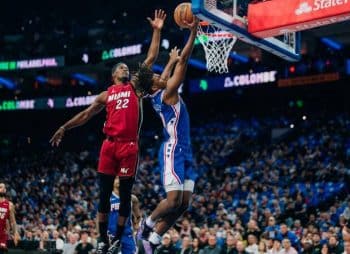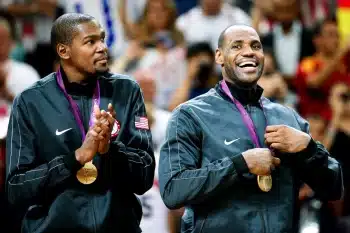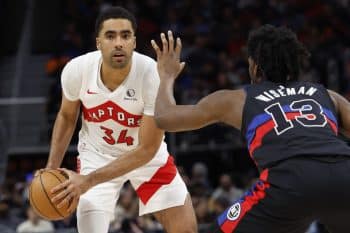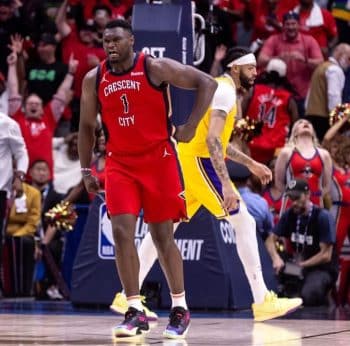NBA
NBA PM: Frank Kaminsky’s Massive Opportunity

With both highs and lows to account for, it’s been an incredibly eventful offseason for the Charlotte Hornets. From trading for Dwight Howard and drafting Malik Monk to the news that defensive stalwart Nicolas Batum would be out for the foreseeable future, the Hornets will start the 2017-18 season off looking considerably different. Still, it’s difficult to see Charlotte stepping into the conference’s upper echelon alongside the Boston Celtics and Cleveland Cavaliers, among others, without some major internal growth.
Down those lines, there may be no better candidate for a breakout season than Frank Kaminsky, the team’s modernly-molded stretch big man. Heading into his third NBA season, Kaminsky struggles at times but has generally affirmed why the Hornets passed on the Celtics’ huge offer and selected the former collegiate stud with the No. 9 overall pick back in 2015. Combined with the more defensive-steady force of Cody Zeller, the Hornets quickly found themselves with a solid, if not spectacular 1-2 punch at the center position.
Unsurprisingly, Kaminsky’s best nights statistically last season came when he hit multiple three-pointers. There were games like his 5-for-9 barrage from deep en route to 23-point, 13-rebound effort against the Sacramento Kings in late February, but his inconsistencies often got in the way just as much. In 2016-17 alone, Kaminsky tallied 41 games in which he converted on one or less of his three-point attempts — and the Hornets’ record? 13-28. Perhaps a tad coincidental for a franchise that finished at 36-46, but the Hornets ranked 11th in three-pointers with an even 10 per contest, so when Marvin Williams (1.6) Marco Belinelli (1.4), Kaminsky (1.5) and Batum (1.8) weren’t hitting, it was often lights out for an ultimately disappointing Charlotte side.
With his 33.1 percent career rate from deep, there’s certainly room to improve for Kaminsky, but his 116 made three-pointers still put him in a special group last season. Of all players at 7-foot or taller, only Brook Lopez made more three-pointers (134) than Kaminsky did — even ranking four ahead of Kristaps Porzingis, one of the league’s most talented unicorns. Once that category is expanded to include those at 6-foot-10 or taller, the list gets far more crowded ahead of Kaminsky, but it’s noteworthy nonetheless.
On that lengthier list of three-point shooting big men is Ryan Anderson, one of the strongest like-for-like comparisons that Kaminsky has today. Drafted in 2008, Anderson has been an elite three-point shooter for quite some time and his 204 makes last season ranked him ninth in the entire NBA. In fact, Anderson’s 2012-13 tally of 213 ranked only behind Stephen Curry; the year before that, his 166 total topped the rest of the field for a first-place finish. Coming out the University of California, Anderson was solid late first-round pickup by the New Jersey Nets and he knocked down one of his 2.9 attempts per game as a rookie.
Then, Anderson was traded to the Orlando Magic in the summer of 2009 and found out that true basketballing nirvana is playing on the same team as prime Dwight Howard. For three seasons, they were a near-perfect fit for each other as Howard averaged 13.9 rebounds and Anderson hit two three-pointers per game over that stretch. Howard deftly made up for Anderson’s defensive shortcomings while the latter stretched the floor effortlessly on the other end.
Although Howard is now considerably older, he’s never recorded a season with an average of 10 rebounds or less over his 13-year career. Howard’s impressive rebounding rate of 20.8 percent — the third-highest mark in NBA history behind Dennis Rodman (23.44) and Reggie Evans (21.87) — has made it easy for his partners to stay at the perimeter or bust out in transition. Other power forwards that have flourished next to Howard also include Rashard Lewis (2.8 three-pointers per game from 2007-09) and Chandler Parsons (1.8 in 2013-14), so there’s some precedent here as well.
Simply put, Howard still demands attention in the post, and Kaminsky is the Hornets’ best possible fit next to him. As Michael Kidd-Gilchrist and Williams will likely slide up a position at times to help navigate Batum’s injury, throwing Kaminsky into the fire seems almost too logical.
An improved sophomore season for Kaminsky saw rises in every major statistical category outside of his percentages due to an increase in volume. However, that 32.8 percent mark from three-point range is considerably lower than the league average and it’ll need to improve for somebody that spends much of the offensive possession ready to fire away. Regardless, Kaminsky’s 11.7 points, 4.5 rebounds and 2.2 assists per game in 2016-17 are a bright sign moving forward, but with Howard, he’s about to be gifted his best opportunity yet.
Whether he’s operating in transition, out of pick-and-pops or catch-and-shoots, Kaminsky has the tools to join the elite stretch forwards in the near future and stay there permanently. Kaminsky’s growing chemistry with All-Star point guard Kemba Walker has made the pair difficult to defend out on the perimeter. From the aforementioned pick-and-pops to a slightly more complicated dribble hand-off, trying to guard the two three-point shooting threats is enough to make your head spin. When he’s not firing from behind the arc, Kaminsky has also exhibited a soft touch and an ability to score among the trees as well.
As he continues to grow and expand his skill set, Kaminsky just needs to find some much-needed consistency as a shooter. If Kaminsky can raise his three-point percentage up closer to the league average this season, he’ll be an invaluable asset for the Hornets as they push for a playoff berth. Over his two full NBA seasons thus far, the Hornets have never had somebody like Howard to pair with Kaminsky and past results for those shooters playing with the future Hall of Famer are promising. Of course, head coach Steve Clifford is a defensive-minded leader — Charlotte’s defensive rating ranked 14th in 2016-17 at 106.1 — so Kaminsky will need to improve there to take full advantage of the available minutes. Fortunately, Howard’s savvy rim protection should make it a palatable experience on both sides of the ball.
When the Hornets rebuffed the Celtics’ massive draft day offer in order to select Kaminsky two years ago, it would’ve been impossible to predict Howard falling right into their lap as well. Between his expanding game and the new frontcourt combination, there’s potential here for Kaminsky to take the next big step in 2017-18.
If and when they do indeed pair him with Howard, the Hornets will be both maximizing his talents as a perimeter threat and minimizing his weaknesses as a defender. While Clifford leaned on Zeller in the past, Howard’s decorated history surrounded by court-stretching shooters should make the decision even easier. Kaminsky’s got all the workings of a modern offensive big man, the faith of the front office and the perfect paint-clogging partner — now it’s up to him to put it all together and become one of Charlotte’s most indispensable players.











